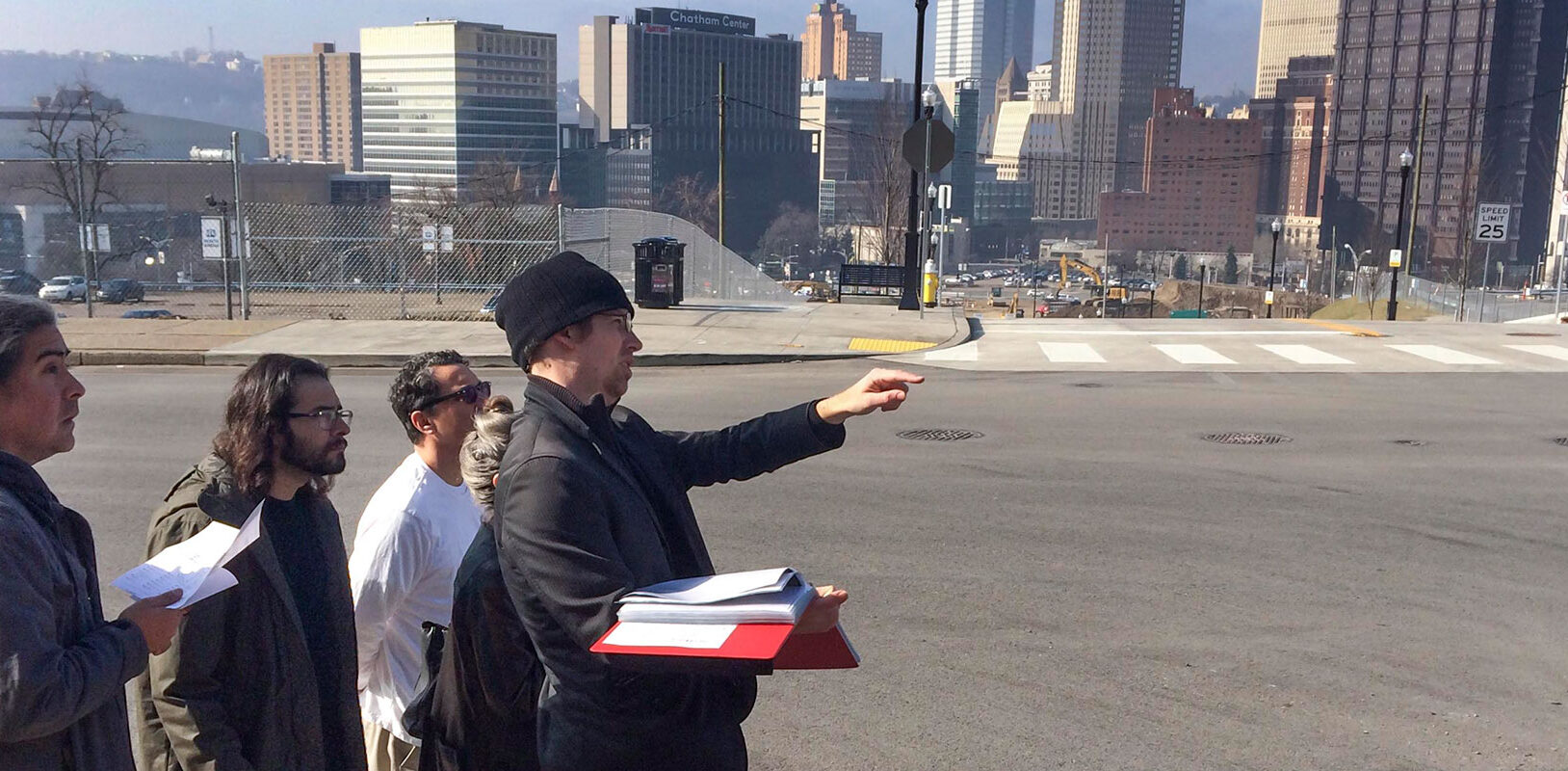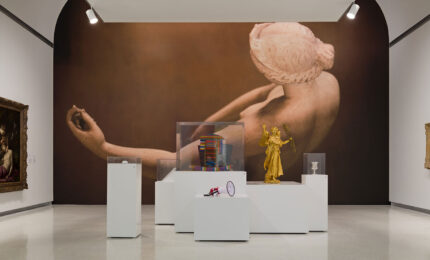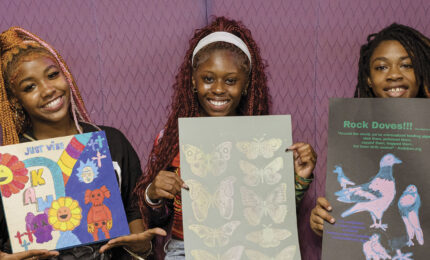Nearly all of the artwork for this year’s Carnegie International is being created new for the exhibition—and, in turn, for Pittsburgh. Curator Ingrid Schaffner started her travel research in 2016, right after the United Kingdom voted to leave the European Union, known as Brexit, and not long before Donald Trump was elected president. “International has become a pressurized term,” says Schaffner, and at the heart of the exhibition shaped by 32 artists and artist collectives and a single independent exhibition maker is an exploration of what it means to be international at this moment in time.
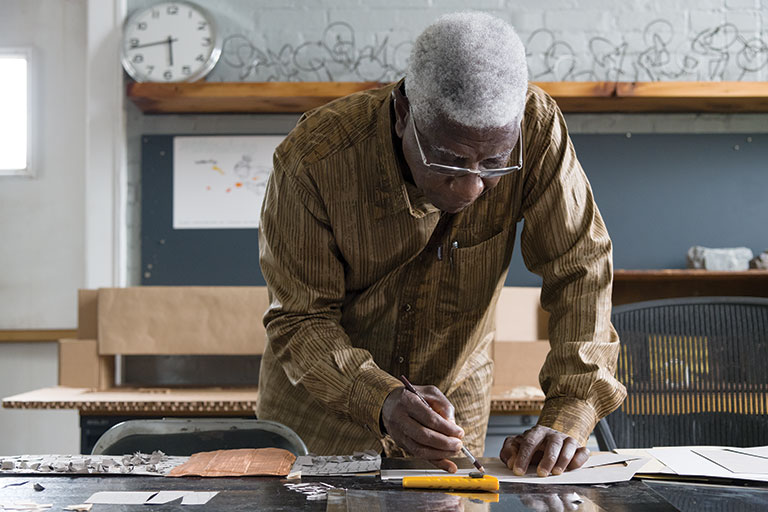
Ghanaian sculptor El Anatsui, whose work now spans the museum’s façade, in the Wilkinsburg studio of sculptor Dee Briggs, who fabricated Anatsui’s work. Photo: Bryan Conley
Participating artists are linked to five continents, and more than half of them live in the United States. For the first time, the majority of the artists identify with the pronoun she. And in announcing the contributors, Schaffner noted both their place of birth and residency, reflecting a world and its people in transition, as well as the idea that place can influence an artist. This movement, whether forced or by choice, is present in the artwork.
Pittsburgh has no doubt influenced four of the artists: Thaddeus Mosley, who has lived and exhibited his soaring wooden sculptures in the city for 65 years; transplants and collaborators Lenka Clayton and Jon Rubin, who will paint in a studio dedicated to turning rejection into acceptance; and generative figure Mel Bochner, whose participation is a celebratory homecoming. Also of note are the “comeback kids,” as Schaffner refers to Jeremy Deller and Kerry James Marshall, a pair of Carnegie International alumni. Marshall, who is widely considered one of the greatest living painters, is revisiting his epic narrative featuring black superheroes two decades after his comic series Rythm Mastr debuted at the 1999 Carnegie International.
Artists visited Pittsburgh, and Pittsburghers joined them in Tam O’Shanter Drawing Sessions.
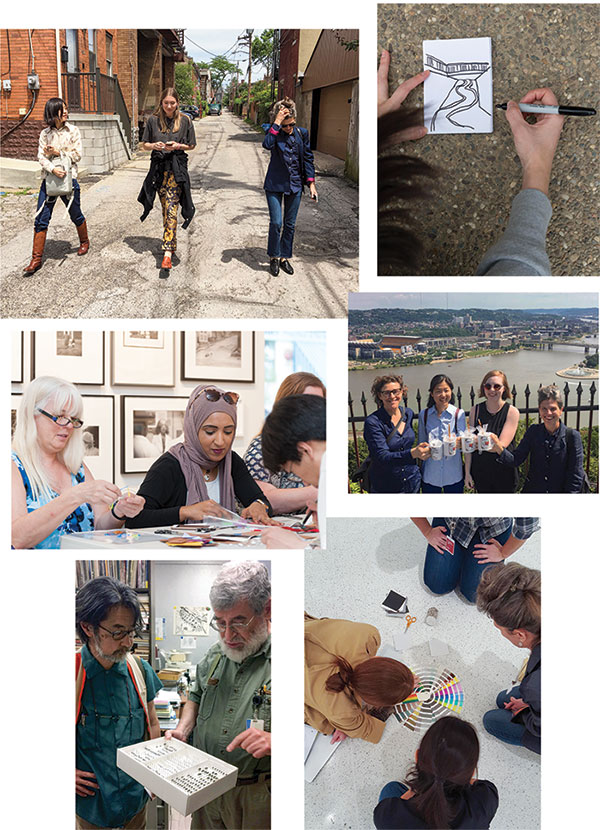
From top left clockwise: Jessi Reaves (center) on Sampsonia Way in the Northside with Liz Park, associate curator of the International, and Ingrid Schaffner, curator of the International; a product of artmaking with Mimi Cherono Ng’ok; Zoe Leonard (left) and the curatorial team—Liz Park, Ashley McNelis, curatorial assistant, and Ingrid Schaffner—on Mt. Washington; Rachel Rose (left) and team looking at Pantone colors in the gallery at Carnegie Museum of Art; Yuji Agematsu (left) discusses insect pins with Robert Davidson, collection manager for invertebrate zoology at Carnegie Museum of Natural History; and participants make Pittsburgh photograms. Photos: Ashley McNelis, Chris Taylor, Sarah Hammond, Liz Park, Bryan Conley
Expect surprises in neon, both inside and on the exterior of the museum. Grab a coffee in Art Labor’s immersive hammock café, which combines research into Vietnam’s coffee industry with painting, sculpture, and sound to create a vibrant and relaxing social experience. And take home an original piece of art—one of 10,632 titles rejected from the first 35 years of the Carnegie International.
But there’s no need to wait until October to dive in, as the Carnegie International is already underway with the Tam O’Shanter Drawing Sessions, which are designed for those who can draw and those who can’t. Continuing through the run of the exhibition (October 13, 2018–March 25, 2019), these intimate adventures in artmaking led by participating artists and other contributors have already included sketching to sculptor Thaddeus Mosley’s personal collection of jazz records, and designing a garment to house an exhibition alongside pocket-museum innovator and bookmaker Dayanita Singh.
The intention of this 57th iteration of the venerable exhibition of contemporary art is “to inspire museum joy,” says Schaffner, through the simple pleasures and provocations of being with art—and other people—and making meaning from that experience. Her invitation: “Take it and play with it.”
